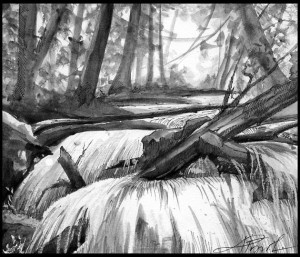
You don’t have to peer too far into the pages of history to find accounts of severe flooding in Vermont and New Hampshire. The Great Flood of 1927 tops Vermont’s all-time list while the Flood of 1936 tops New Hampshire’s.
But you do have to peer back. Despite today’s changing climate and unusual weather patterns – and predictions of worse things to come – neither state has experienced a widespread, cataclysmic deluge in many decades. Why is that?
There are two reasons, and neither one has to do with rainfall. We’ve had plenty of rain in recent years, with the past 18 months being about as wet as most people can recall. There has even been some serious flooding: the downpour in Alstead, New Hampshire, last October is the most recent example. But while the damage from that flood was severe, it was isolated to a few towns.
Vermont’s Great Flood of 1927 was another story altogether: dozens of people across the state died, mostly from drowning, including the lieutenant governor. The total damage to the state’s roads, bridges, and buildings was eventually tallied at $8.5 million, which was two and a half times the entire state budget at the time. Vermont hasn’t seen a flood like that since…well, since then.
The two reasons why we haven’t seen recent floods like that are both ecological. First is that the forests of both states have regrown dramatically in the past half-century. Forests are excellent at storing water, both in their roots and trunks and in the soil that is held in place by all those roots. A thick duff of leaves and needles acts just like a sponge, soaking up water during a downpour for slow release later on. Our forests cushion the blow, dissipating the intense energy of major storms and spreading the water out over time.
This is only true up to a point, of course – no forest can absorb rain falling at the sustained rate of several inches per hour. But rain of that magnitude is usually confined to specific cloudbursts, meaning that the resulting flooding is also isolated to a small area, not the entire region.
The second reason why haven’t had such monumental floods in recent years is because we’ve allowed some of our streams and stream banks to return to a more natural condition. It was common in earlier days for people to remove trees and debris from streams and rivers in order to keep them flowing fast. Indeed, gravel was often dredged from our local rivers to deepen the channel, and particularly crooked sections of streams were sometimes straightened to remove obstacles. The impetus for doing this work was obvious to anyone who has watched water running down a drainage ditch: if you don’t remove the leaves and debris, the water will back up and flood.
But all the backing up and flooding in ditches and feeder streams is what prevents floods from becoming regional and causing severe damage downstream. Swollen, debris-filled streams help hold the storm surge back from the major rivers; straightened, cleaned-out streams only deliver the problem downstream at a high rate of speed. As our forests have grown back, many of the streams that used to flow through open pastures are now deep in the woods, where wooded floodplains and fallen trees have restored the ability of these streams to hold back flood waters.
The key, of course, is that we all need to be in this together: if some landowners decide to keep their own streams clear, they will be reducing the flood risk on their own property while increasing the danger for everyone downstream. To address this issue, New Hampshire has statewide regulations to protect streamside buffers while Vermont is considering enacting the same.
The flood-control protection that forests provide falls into a category that ecologists have tagged, rather boringly, as “ecological services.” Our local forests help control floods, clean the air, moderate the climate, and, at this time of year, provide spectacular scenery. Just how much are these services worth to our local economy? That’s almost impossible to quantify. Annual leaf-peeper revenues alone run into the tens of millions of dollars. If our forests help prevent the next Great Flood of 1927, that will be a savings of nearly $4 billion, assuming the cleanup would cost two and a half times Vermont’s annual budget.
All of this isn’t to say that we’re completely out of the woods. The hurricane cycle is strengthening again, many of our streams are still hemmed in by roads and development, and a combination of spring downpours and a thick snow pack could certainly get us back into the history books. But it’s nice to know that, compared with a century ago, our forests are back on the case.

